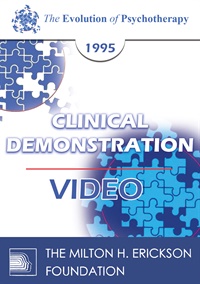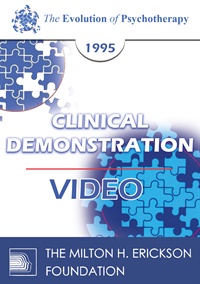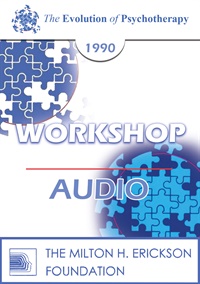
- Average Rating:
- Not yet rated
- Topic Areas:
- Workshops | Bioenergetics | Mind-Body | Psychosomatics | Psychotherapy
- Categories:
- Evolution of Psychotherapy | Evolution of Psychotherapy 1990
- Faculty:
- Alexander Lowen, MD
- Duration:
- 2 Hours 36 Minutes
- Format:
- Audio Only
- Original Program Date:
- Dec 16, 1990
- Short Description:
- This workshop will focus on physical (muscular) tension in the body and relate it to emotional conflicts in the present, derived from early childhood experiences. Specific attention will be paid to temporomandibular tension and to disturbances in breathing. Asthma will be examined as an emotional problem. The dynamics of headaches will be studied, and techniques for releasing underlying tension will be demonstrated.
- Price:
- $15.00 - Base Price
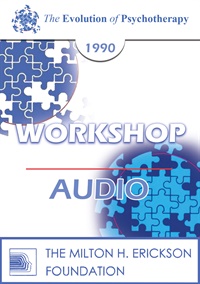
- Average Rating:
- Not yet rated
- Topic Areas:
- Workshops | Reality Therapy | Psychotherapy
- Categories:
- Evolution of Psychotherapy | Evolution of Psychotherapy 1990
- Faculty:
- William Glasser, MD
- Duration:
- 2 Hours 35 Minutes
- Format:
- Audio Only
- Original Program Date:
- Dec 16, 1990
- Short Description:
- This workshop will show, through a series of clinical demonstrations (using attendees from the workshop as role-players), how Reality Therapy works with different types of clients.
- Price:
- $15.00 - Base Price
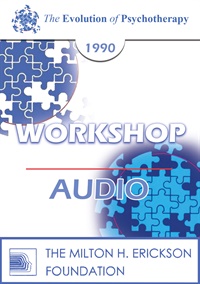
- Average Rating:
- Not yet rated
- Topic Areas:
- Workshops | Group Therapy | Psychotherapy | Redecision Therapy
- Categories:
- Evolution of Psychotherapy | Evolution of Psychotherapy 1990
- Faculty:
- Mary Goulding, MSW
- Duration:
- 2 Hours 32 Minutes
- Format:
- Audio Only
- Original Program Date:
- Dec 16, 1990
- Short Description:
- A therapy group will be formed from Conference participants, in order to demonstrate what can be accomplished in a single group session. Emphasis will be on establishing therapeutic contracts for change and using the past to effect this change. Discussion and whole-group experiences will follow the therapy demonstration.
- Price:
- $15.00 - Base Price
- Average Rating:
- Not yet rated
- Topic Areas:
- Clinical Demonstrations | Psychotherapy
- Categories:
- Evolution of Psychotherapy | Evolution of Psychotherapy 1995
- Faculty:
- Jeffrey Zeig, PhD
- Course Levels:
- Master Degree or Higher in Health-Related Field
- Duration:
- 55:40
- Format:
- Audio and Video
- Original Program Date:
- Dec 15, 1995
- Short Description:
- Educational Objectives: To describe the method of "orienting toward." Given a patient, demonstrate appropriate use of the technique of guiding associations.
- Price:
- $59.00 - Base Price
Tags: Jeff Zeig Psychotherapy
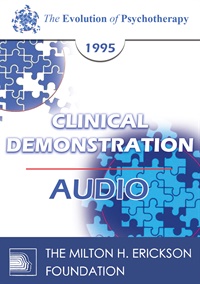
- Average Rating:
- Not yet rated
- Topic Areas:
- Clinical Demonstrations | Psychotherapy | Supervision
- Categories:
- Evolution of Psychotherapy | Evolution of Psychotherapy 1995
- Faculty:
- Otto Kernberg, MD
- Duration:
- 54:08
- Format:
- Audio Only
- Original Program Date:
- Dec 15, 1995
- Short Description:
- Clinical Demonstration 03 from the Evolution of Psychotherapy 1995 - Supervision of a Psychodynamic Psychotherapy
- Price:
- $15.00 - Base Price
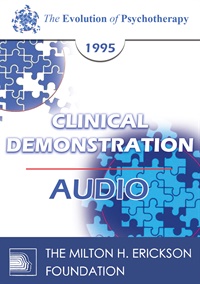
- Average Rating:
- Not yet rated
- Topic Areas:
- Clinical Demonstrations | Hypnotherapy | Interviewing | Psychotherapy | Art and Creativity
- Categories:
- Evolution of Psychotherapy | Evolution of Psychotherapy 1995
- Faculty:
- Ernest Rossi, PhD
- Duration:
- 57 Minutes
- Format:
- Audio Only
- Original Program Date:
- Dec 15, 1995
- Short Description:
- Educational Objectives: To describe the three-step Basic Accessing Question to facilitate reactive reorganization of the problem. To demonstrate two variations of the Basic Accessing Question in Depth Psychotherapy.
- Price:
- $15.00 - Base Price
- Average Rating:
- Not yet rated
- Topic Areas:
- Clinical Demonstrations | Brief Therapy | Dreamwork | Psychotherapy
- Categories:
- Evolution of Psychotherapy | Evolution of Psychotherapy 1995
- Faculty:
- James Hillman, PhD
- Course Levels:
- Master Degree or Higher in Health-Related Field
- Duration:
- 57:49
- Format:
- Audio and Video
- Original Program Date:
- Dec 15, 1995
- Short Description:
- Educational Objectives: To list three reasons for working with dreams in the initial interview and in brief psychotherapy. Given patients with no dreaming, list techniques for eliciting dreams and for "dream substitutes."
- Price:
-
Sale is $29.00
price reduced from Base Price - $59.00
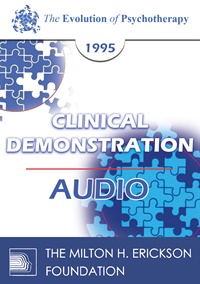
- Average Rating:
- Not yet rated
- Topic Areas:
- Clinical Demonstrations | Psychotherapy | Therapist Development
- Categories:
- Evolution of Psychotherapy | Evolution of Psychotherapy 1995
- Faculty:
- Erving Polster, PhD
- Duration:
- 53 Minutes
- Format:
- Audio Only
- Original Program Date:
- Dec 15, 1995
- Short Description:
- Clinical Demonstration 11 from the Evolution of Psychotherapy 1995 - Humanization of Technique, featuring Erving Polster, PhD. Educational Objectives: To describe and illustrate the difference between ordinary human engagement in therapy and technical engagement. To describe a moment when you could discern a felt meeting of minds between patient and therapist.
- Price:
- $15.00 - Base Price

- Average Rating:
- Not yet rated
- Topic Areas:
- Clinical Demonstrations | Rational Emotive Behavior Therapy (REBT) | Psychotherapy
- Categories:
- Evolution of Psychotherapy | Evolution of Psychotherapy 1995
- Faculty:
- Albert Ellis, PhD
- Duration:
- 58 Minutes
- Format:
- Audio Only
- Original Program Date:
- Dec 16, 1995
- Short Description:
- Educational Objectives: To list three of the main techniques of Rational Emotive Behavior Therapy (REBT). To experiment with some of these techniques.
- Price:
- $15.00 - Base Price
Tags: Psychotherapy REBT Albert Ellis
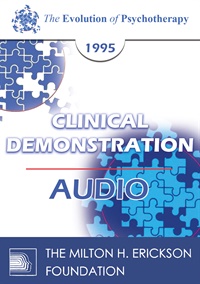
- Average Rating:
- Not yet rated
- Topic Areas:
- Clinical Demonstrations | Redecision Therapy | Brief Therapy | Psychotherapy
- Categories:
- Evolution of Psychotherapy | Evolution of Psychotherapy 1995
- Faculty:
- Mary Goulding, MSW
- Duration:
- 57 Minutes
- Format:
- Audio Only
- Original Program Date:
- Dec 16, 1995
- Short Description:
- Educational Objectives: To list three viable contracts for change by the patient. Ballroom ABC To describe the use of early child scenes in making changes in the present.
- Price:
- $15.00 - Base Price
Please wait ...


